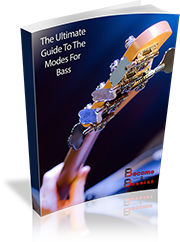If you’ve checked out the previous lesson all about how to play the modes on bass, you would have learned how the modes work and that they’re all related. But what now? You might be wondering,
“If the modes are all the same set of notes, why bother with them at all? Won’t everything just sound the same?“
Well yes AND no. Yes – it is the same set of notes, but no – they don’t all sound the same.
You see each of the modes have a distinct sound – even though they all use the same notes. This seems counter-intuitive, right? You would think the same notes should produce the same sound, even though they’re in a different order. However, the way the modes are structured makes each of them sound very different.
Some of the modes sound very ‘bright‘ like the Lydian mode and other sound very ‘dark‘, like Locrian. Each of the modes also corresponds to a chord – and this is where the modes shine!
Check out the lesson to see the relationship between chords and the modes and learn exactly where and how you can use the modes to create music.
Video Not Showing Up Here? Watch On YouTube

Stop Struggling With The Modes On bass
FREE - Download the 16-page Ultimate Guide To The Modes Of The Major Scale For Bass and:
- Get a full explanation of the modes in simple, easy-to-understand terms
- Discover how the modes REALLY work and how they're related to different chords
- Learn how to use the modes, and where you can use each of them
- Download the free PDF guide plus 24 practice tracks that will have you using the modes TODAY
This is fantastic, right? There are 7 notes in a major scale, 7 chords that you can make from the scale and 7 modes. As a result, everything lines up perfectly. If you know the key you’re in and the chords of the song, then you’ll never play a ‘wrong‘ note again.
All you have to do is play the appropriate mode for the chord and the mode will take care of the rest. This is great if you’re improvising or making fills, but it’s also handy if you’re making your own bass lines.
I highly recommend you try out the exercise from the lesson – it’ll have you playing all of your modes right away. If you sign up for The Ultimate Guide To The Modes For Bass, you’ll get the practice tracks from the lesson in every key as well as the charts for the modes. You also get the notation and tabs for each of them as well. I’ve got you covered no matter which one you prefer.
You’ll also learn how to ‘translate‘ a set of chords into a modal roadmap so you’ll always know exactly what to play. This can be an absolute blast when you get the hang of it so go for it! If you have any questions about anything in the lesson or the Ultimate Guide, just email me or leave a comment below.
Good luck with the lesson and happy playing!
Cheers,



Hey Luke!
My name Is Gil Grosman I am from Israel now living in NYC.
First of all, thank you for your eye-opening videos!! I am an ex-progressive metal bassist turning into Jazz musician, well trying too.
Thank you for everything!
your videos helped me so much.
Hey Gil – Thanks so much for watching. It sounds like you really got a lot out of the videos. Good luck making the transition from metal to jazz! I did a similar thing when I was younger – played in hard rock/semi-metal bands and then started playing jazz when I was 18-ish! I’m sure you’ll love it.
Let me know if you have any questions at all. I’d be happy to help out.
thanks Luke your lessons are great.
Thanks Luke
I finally got it. Stay Safe